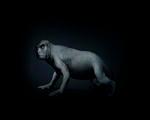Origin
Daniel Lee
李小鏡
Production date
1999-2003
Object Detail
Media
digital video animation (colour, sound)
Measurements
2 min 30 sec
Notes
Origin (1999–2003) was shown in its earliest iteration in New York at the very end of the twentieth century, amidst the anxieties surrounding the dawn of the new millennium. Comprising a series of digitally manipulated images and an animation, Origin represents human evolution based on Lee’s imagining, in ten stages of metamorphosis from fish to reptile, from mammal to monkey, and finally from great ape to human.By 1999, Lee was thinking deeply about the social and scientific challenges of the new century, and working on ways to use the computer as an extension of his photography.
The critical and popular reaction to his earlier ‘evolutionary self-portrait’ series was so positive that Lee decided to create a sequence of ten transformations — from an amphibian to a human. He started with a fish that he bought at the market in New York’s Chinatown, using it as a model for the prehistoric coelecanth, a fish once known only from fossils and thought to have become extinct at the same time as the dinosaurs, 65 million years ago, but discovered in the twentieth century living in the West Indian Ocean. Through an immensely time-consuming and complex process, Lee built up composite reptilian, mammalian and simian creatures as the interim stages between the fish and his two human models. The resulting series of still images and the slow-motion video are at once compelling and disturbing.
The transformation, representing millions of years of evolution, is almost unbearably slow, as fins melt away to become legs, an amphibian becomes a mammal, and this quadruped very gradually becomes a man, his unsettling gaze turned upon the viewer. Creatures whose ancestors emerged from the oceans and primeval swamps face an unimaginable future. The final image of a crouching man emphasises his animal nature: he does not stand upright, a very deliberate choice on the part of the artist. Some have speculated that the work is a comment on the ethical challenges of biotechnology — and indeed, Lee has spoken about the ‘sorrow’ that might be felt by experimental pigs grown with human organs. It might also be read as a Buddhist-inspired comment on the interconnectedness of all life forms, and the obligations of human kindness.
The critical and popular reaction to his earlier ‘evolutionary self-portrait’ series was so positive that Lee decided to create a sequence of ten transformations — from an amphibian to a human. He started with a fish that he bought at the market in New York’s Chinatown, using it as a model for the prehistoric coelecanth, a fish once known only from fossils and thought to have become extinct at the same time as the dinosaurs, 65 million years ago, but discovered in the twentieth century living in the West Indian Ocean. Through an immensely time-consuming and complex process, Lee built up composite reptilian, mammalian and simian creatures as the interim stages between the fish and his two human models. The resulting series of still images and the slow-motion video are at once compelling and disturbing.
The transformation, representing millions of years of evolution, is almost unbearably slow, as fins melt away to become legs, an amphibian becomes a mammal, and this quadruped very gradually becomes a man, his unsettling gaze turned upon the viewer. Creatures whose ancestors emerged from the oceans and primeval swamps face an unimaginable future. The final image of a crouching man emphasises his animal nature: he does not stand upright, a very deliberate choice on the part of the artist. Some have speculated that the work is a comment on the ethical challenges of biotechnology — and indeed, Lee has spoken about the ‘sorrow’ that might be felt by experimental pigs grown with human organs. It might also be read as a Buddhist-inspired comment on the interconnectedness of all life forms, and the obligations of human kindness.
Accession number
2014.009

